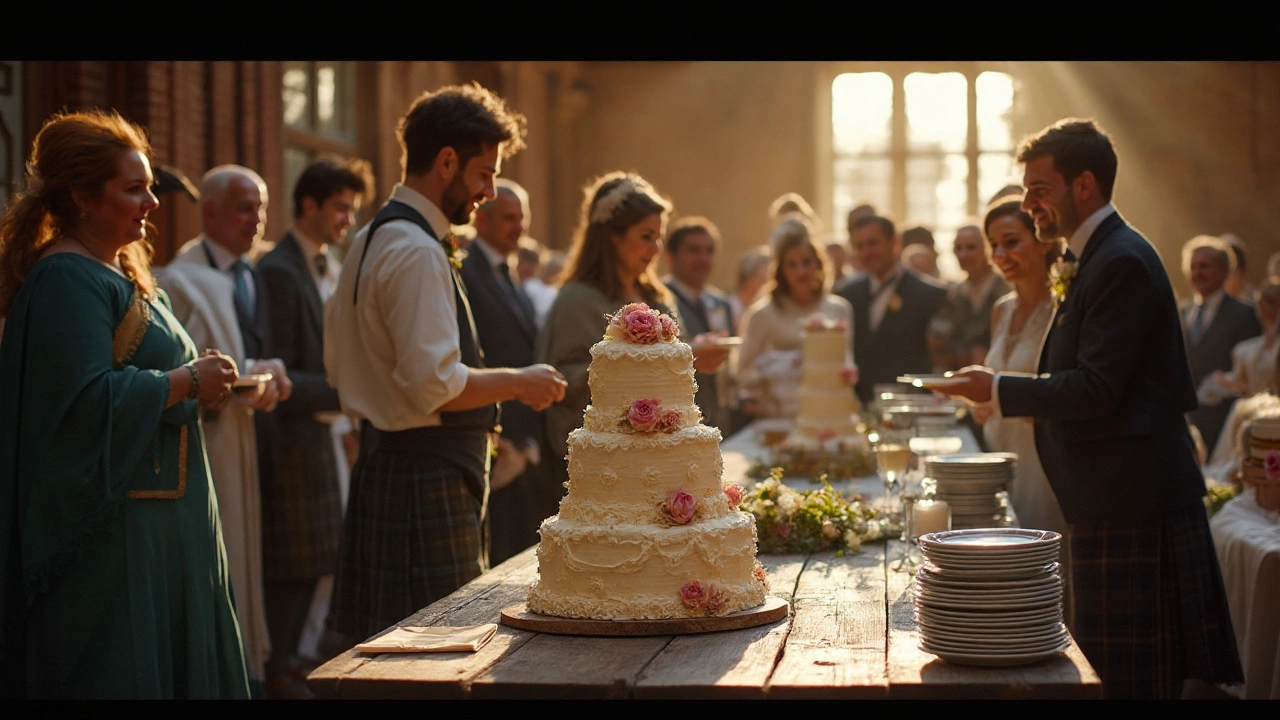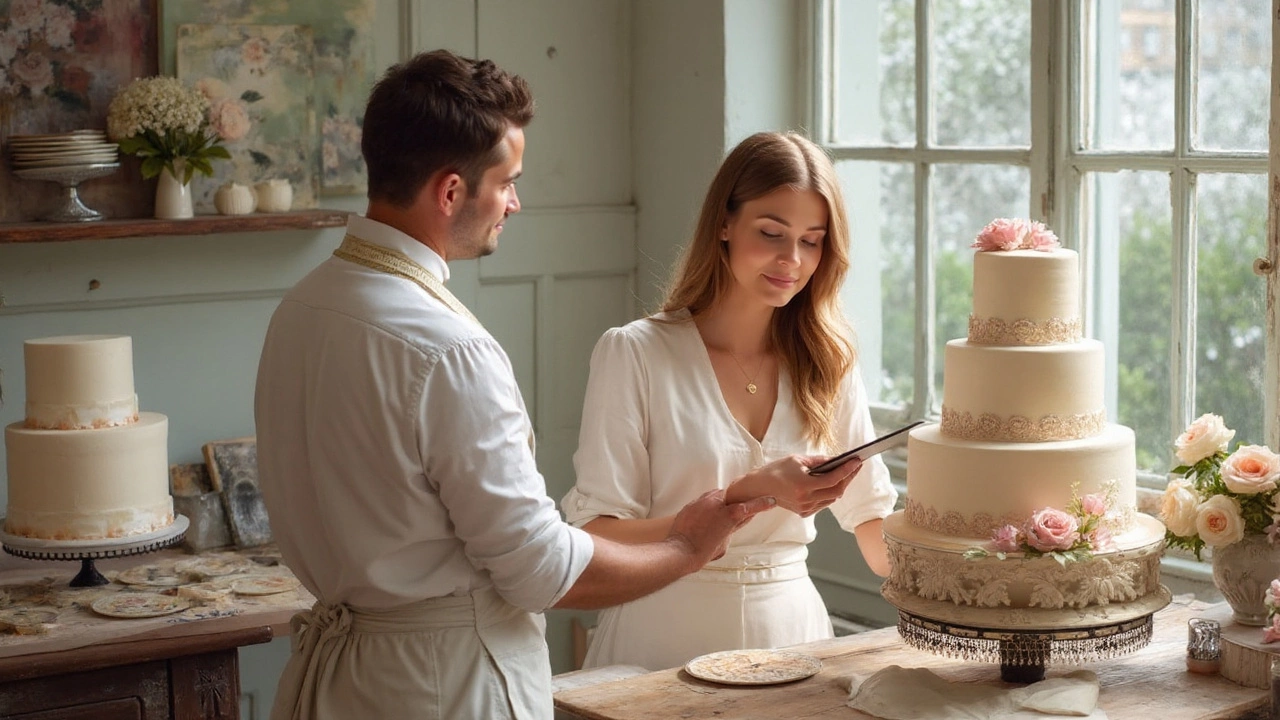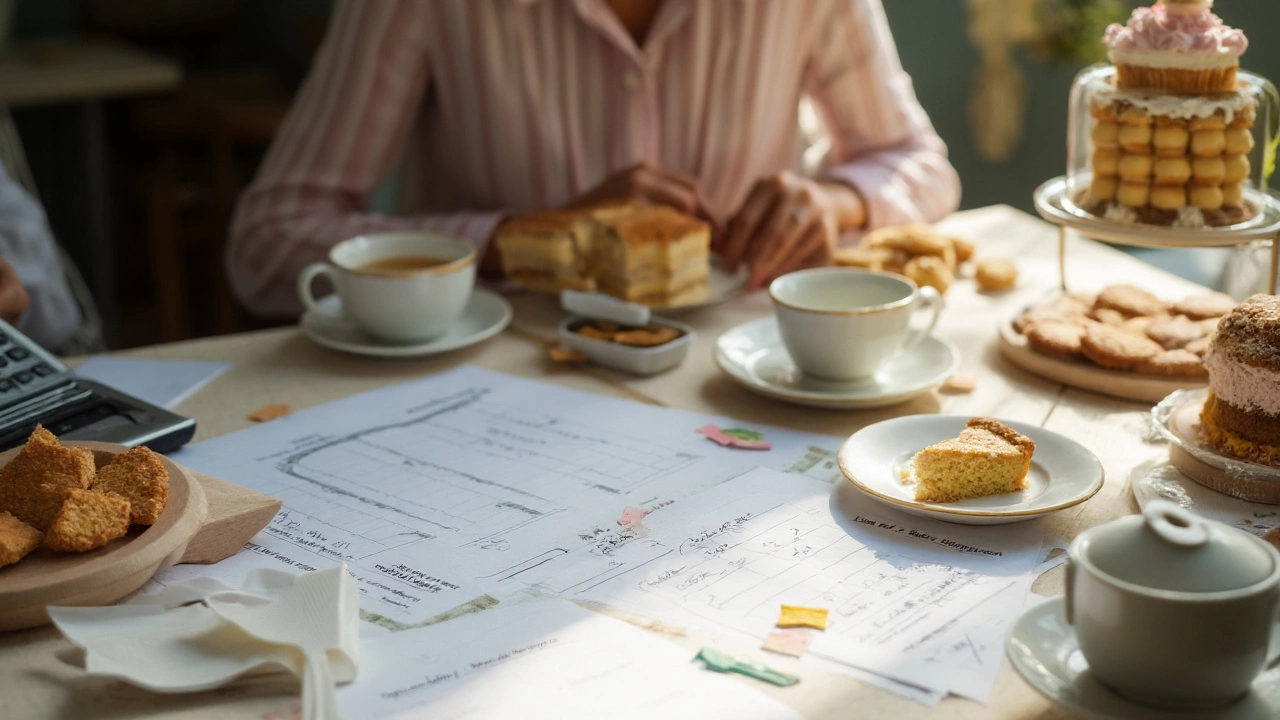You don’t need cake for every single guest. At most weddings, about 8 in 10 people actually eat a slice-sometimes more, sometimes less. The real win is ordering the right amount without blowing the budget or running out during the sweetest moment of the night. Here’s the straight answer, the math, and the tiny factors that quietly swing your numbers up or down.
Short answer, key takeaways, and what actually drives cake-eating
TL;DR
- Typical range: 70-90% of guests eat cake; most planners and bakers budget for about 80% when other desserts are available, and 90-100% when cake is the only dessert.
- What moves the number: dessert competition, timing of cake cutting, alcohol and dancing, guest mix (kids vs. older guests), and venue service style.
- Serving size baseline: a classic wedding slice is 1 × 2 × 4 inches. Use that for your counts; upsizing slices can drain your cake fast.
- Cupcakes? Order roughly 1 per guest plus a 5-10% buffer. Macarons or minis require 2-3 pieces per person if they’re subbing for cake.
- Use the quick calculator below to turn guest count into the right number of servings and tiers/sheet cake backups.
There isn’t a national census on cake-eating at weddings, and your guest list isn’t a lab sample anyway. But there is reliable industry guidance. Caterers and bakers commonly plan for 75-85% of guests to take a slice when a dessert bar is also in play, and closer to 90-100% when cake is the star. Wilton’s long-standing serving standards (that 1 × 2 × 4-inch slice) anchor how pros size tiers and sheet cakes. Annual surveys like The Knot’s Real Weddings Study and WeddingWire reports show cake remains the default dessert, even as couples add donuts, late-night snacks, or gelato carts-which, yes, lowers actual cake uptake.
So what makes your number lean toward 70% or spike toward 90%? A handful of levers you can control:
- How many other sweets you’re serving. More options = fewer cake slices taken.
- Timing of the cut. Cut earlier (right after dinner) and more guests say yes. Cut after 10 p.m., and you’ll see more people on the dance floor than in the dessert line.
- Service style. Plated slices in front of guests increase consumption; a buffet line introduces friction and drop-off.
- Alcohol and dancing. Heavier drinking and a loud, packed dance floor reduce dessert participation.
- Guest mix. Older guests and families linger at tables and tend to eat cake. A mostly 20s-30s cocktail crowd often grabs fewer slices.
- Dietary access. Offer labeled gluten-free/vegan options and more guests can actually partake.
| Scenario | Realistic % who eat cake | Order for this % of guests | Notes |
|---|---|---|---|
| Cake is the only dessert; cut right after dinner; plated service | 85-95% | 90-100% | Plated slices boost uptake; near-universal participation |
| Cake + dessert bar; cut right after dinner | 75-85% | 80% | Guests split choices; earlier cut helps |
| Late-night cake cut (after 9:30 p.m.) + dancing + open bar | 65-80% | 70-80% | Late timing and energy reduce participation |
| Brunch/lunch wedding; coffee service; no second dessert | 80-90% | 85-90% | Coffee + daylight = higher acceptance |
| Outdoor summer reception; dessert table loaded; self-serve | 65-75% | 70-75% | Heat + options + buffet friction |
If you want one number without overthinking it, order for 80% of your guest count when there’s any other dessert and 90% when there isn’t.

How much cake to order: the simple calculator, examples, and sizes
Use this quick path. You’ll have a precise number in two minutes.
- Pick your target percentage. Start with 80% if you’ll have other desserts; 90% if cake is the only dessert. Push up or down 5-10 points based on your scenario table above.
- Multiply by guest count. Servings needed = total invited guests × target % (in decimal). For 150 guests at 80%: 150 × 0.80 = 120 servings.
- Adjust for kids and vendors. Kids under 10 often share or skip. Count them at 0.5 each unless they’re dessert fanatics. Add 5-10 vendor servings (check your contracts) if they’ll be present during dessert.
- Lock your serving size. Standard wedding slice is 1 × 2 × 4 inches. If your caterer plans thicker slices, increase servings by 10-20% or ask them to pre-mark the cake for consistent cuts.
- Choose cake formats. Display tiers for the photos, sheet cakes in the kitchen for volume, or go all cupcakes. Mix and match to nail budget and aesthetics.
That’s your baseline. Now map servings to real cake sizes.
| Common Cake/Tier | Typical Servings (1×2×4 in) | Notes |
|---|---|---|
| 6" round | 12 | Top tier (often saved) |
| 8" round | 24 | Workhorse middle tier |
| 9" round | 32 | Alternative to 10" for certain designs |
| 10" round | 38 | Great for volume without towering height |
| 12" round | 56 | Big base tier |
| Half sheet (approx. 12×18×2") | 54-64 | Back-of-house budget helper |
| Full sheet (approx. 18×24×2") | 108-128 | Large receptions; easy to portion |
| Cupcakes | 1 per guest (+5-10%) | Offer minis at 1.5-2 per guest |
Note: Serving counts vary slightly by bakery. Confirm with yours before you lock tiers.
Examples you can borrow
- 150 guests + dessert bar. Target 80% → 150 × 0.80 = 120 servings. Kids: 10 kids × 0.5 = 5 “adult-equivalent” servings. Vendors: +8. New total ≈ 133. Plan a 4-tier display (12" + 10" + 8" + 6" ≈ 130-140 servings) and you’re set without extra sheet cake.
- 180 guests, cake only, cut after dinner. Target 90% → 180 × 0.90 = 162 servings. Vendors: +6 → 168. Choose 12" + 10" + 8" + 6" (≈ 130-140) + one half-sheet (≈ 54-64). You’ll land around 184-204 servings with buffer, or use a 5-tier display if you want no sheet cake.
- 90 guests, brunch wedding. Target 85% → 90 × 0.85 = 76.5 ≈ 77 servings. 6" + 8" + 10" tiers (≈ 74-86) covers it. If you’re saving the 6" top tier, add a dozen cupcakes or a small kitchen cake.
- 200 guests, late-night cut, heavy dancing + donut wall. Target 70% → 200 × 0.70 = 140 servings. Vendors: +8 → 148. A 4-tier (12" + 10" + 8" + 6") around 130-140 servings plus a small half-sheet gives you comfort without waste.
- 120 guests, mixed dietary needs (gluten-free + vegan). Target 80% → 96 servings total. Make 15-20% of those GF/vegan (≈ 15-20 servings). That can be a small side cake or labeled cupcakes so guests with restrictions can participate.
Handy formulas
- Servings needed = (Adult guests + 0.5 × child guests) × target % + vendor servings
- Target % = choose 0.70, 0.80, 0.90, or 1.00 using the scenario table
- Slice size control: If slices will be larger than 1 × 2 × 4 in, multiply servings by 1.1-1.2 to compensate
Display cake vs. sheet cake vs. cupcakes
- Display tiers are for photos and presentation. Order enough tiers to serve 50-75% of your count visually, then pad volume with sheet cakes cut in the kitchen.
- Sheet cakes are cheaper per serving, easier to portion, and guests never notice. Your budget’s best friend.
- Cupcakes make portioning and dietary labels easy. Order 1 per guest + 5-10%. Minis need 1.5-2 per person if they’re the only dessert.
Pro tip: Ask your baker to pre-score the back-of-house sheet cakes. It keeps portions consistent and prevents the “giant slice” problem that wipes out half your servings early.
Because a lot of couples search for wedding cake servings, here’s the straight mapping: decide your target % with the table, multiply, then match that number to tiers and sheet cakes using the serving chart. That’s it-no complex calculator needed.

Checklist, pitfalls, FAQ, and next steps
Here’s where couples either nail it or end up with a fridge full of frosting. Use this as your quick run-through before you sign the bakery contract.
Fast checklist (10 items)
- Pick your target % (70/80/90/100) using the scenario table.
- Count kids at half, add vendor slices.
- Confirm serving size (1 × 2 × 4 in) with your caterer.
- Decide slice service: plated (more eaten) vs. buffet (less eaten).
- Lock timing of the cake cut-earlier means higher participation.
- Choose your display vs. sheet cake mix for budget and look.
- Order 15-20% of servings as GF/vegan if you have many dietary needs.
- Ask for pre-scored sheet cakes and a cutting diagram for staff.
- Plan signage: flavors, allergens, and where to find GF/vegan options.
- Decide on to-go boxes if you expect leftovers (or arrange staff to tray-pass slices to tables).
Common pitfalls to avoid
- Late cuts with no announcement. Guests miss it, and cake sits untouched. Have your DJ or band announce dessert and keep the line moving.
- Too many competing sweets. A donut wall, gelato cart, s’mores station, and a cake guarantees leftovers. If you want it all, lower the cake order to 70-75%.
- Oversized slices. One heavy-handed server can burn through 30 servings in 15 plates. Pre-score and train the team.
- Not accounting for saved top tier. If you’re saving the top tier, exclude those servings from the count or add a small kitchen cake to cover the gap.
- Forgetting vendors. Your photo/video team may be gone by dessert. If they won’t be there, remove those servings from the plan.
Decision aid: what % should you pick?
- Choose 70-75% if: late-night cut, heavy dancing/open bar, multiple dessert stations, buffet service, outdoors in summer heat.
- Choose 80-85% if: cake + modest dessert bar, cut right after dinner, mixed-age crowd, coffee service.
- Choose 90-100% if: cake is the only dessert, plated service, early evening cut, brunch/lunch reception, lots of family/older guests.
Mini-FAQ
- Do children count the same as adults? Usually not. Count kids under 10 as half a serving unless you know your crew loves dessert.
- What if we serve cupcakes instead of cake? Order ~1 cupcake per guest plus 5-10% buffer. If offering minis only, plan 1.5-2 per guest.
- We’re saving the top tier. Do we need more cake? Yes, unless your total already covers it. If your top tier is ~12 servings and you want to save it, add ~12 servings via sheet cake or cupcakes.
- How many gluten-free/vegan servings should we order? If you have 10-15% of guests with restrictions, aim for 15-20% of your servings in those options. Make them clearly labeled and easy to find.
- What if people don’t eat the cake-can we serve it later? Yes. Tray-pass small slices on the dance floor or at last call, or box up slices for a sweet take-home favor.
- Is the 1 × 2 × 4-inch slice really standard? Yes. It’s the industry baseline for sizing tiers and charts (used by major baking standards and instructional guides). If your caterer cuts larger, adjust your order up.
- Do we need extra for vendors? Only if they’ll still be on-site at dessert time and your contract includes a hot meal/dessert. Add 5-10 servings if needed.
- What if we’re doing a dessert bar and a small ceremonial cake? Order a small 2-3 tier for photos (serves ~50-75), and let the dessert bar carry the rest. Use the 70-75% rule for the total dessert servings across all items.
Next steps and troubleshooting by scenario
- Budget-focused couples. Use a 3-tier display for the look and back it with sheet cakes for the bulk. Price per serving drops, and no one knows the difference once it’s plated.
- Dessert lovers who want it all. Keep the cake at 70-75% and give the spotlight to your donut wall, pie bar, or gelato. Make sure signage points to GF/vegan options so everyone finds something.
- Micro-wedding (under 50 guests). Smaller groups tend to eat a higher percentage. Go 85-100% depending on timing. A 2-tier (6" + 8") plus a dozen cupcakes covers you with a sweet buffer.
- Large guest lists (200+). Service efficiency matters more than anything. Pre-score sheet cakes, assign two cutters, and plate slices so they appear at tables. Consider two dessert stations to prevent bottlenecks.
- Destination or outdoor summer weddings. Heat suppresses dessert intake and melts buttercream. Target 70-80%, pick heat-safe fillings (no delicate mousse outdoors), and cut earlier in the evening.
- Cultural dessert traditions. If you’re also offering traditional sweets (baklava, mochi, ladoos), reduce cake to 70-80% and elevate the heritage desserts with labels and placement near coffee/tea.
- Service running behind. If dinner is late, don’t push cake past 10 p.m. Move to a quick cake cut right after mains, then open the dance floor. You’ll save your consumption rate.
- Worried about waste. Ask your caterer to tray-pass cake after the initial rush. People say yes to a bite-sized slice brought to them way more than they’ll stand in line for it at 10:30.
If you’re working with your baker this week, bring three numbers: guest count, your target percentage, and the exact serving size plan. From there, align on tiers vs. sheet cake, label dietary options, and set the cake-cut time on the timeline. That’s how you turn a fuzzy guess into a smooth, sweet moment-no panic, no pile of leftovers.
Bottom line: expect 70-90% of guests to eat cake, with 80% as the safest starting point when other desserts exist. Use the calculator to convert that into servings, then match to tiers and sheet cakes. You’ll have enough for the photo, the sweet tooths, and the folks who only want a polite two-bite slice.
